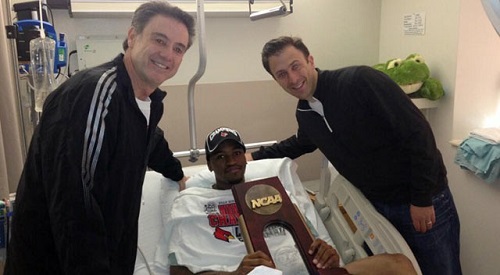
Looking Beyond the Kevin Ware Injury
I haven’t seen Kevin Ware’s injury. I hope I never do.
On Sunday when it happened I was watching his Louisville Cardinals take on (and eventually defeat) the Duke Blue Devils. Thankfully I am of a generation to which one screen isn’t enough, and I also happened to be watching a movie on another television.
I was caught up in the movie during the moment of impact.
It didn’t take long for my attention to shift to the screen where Ware’s horrific pain was playing out before millions. A friend who was with me first noticed that play was stopped, followed by the realization that CBS was only showing people’s faces. Faces that looked like they were going to be sick, faces that had just witnessed something terrible.
The faces told me something had gone very, very wrong, but I didn’t know what that was exactly. I turned up the volume and pulled up Tweetdeck to see what exactly had happened. A string of tweets told me Kevin Ware had suffered a catastrophic injury, one that had made more than one viewer queasy. Several reports came out that Louisville players had thrown up on the bench; Rick Pitino said he almost lost it himself.
[php snippet=1]
Since then the closest I have come to seeing the actual injury is a .gif of the Louisville bench when it happened. Ware’s teammates recoil in abject terror of what they see; something that firms my resolve to avoid video of the incident at all costs.
But as I sat there watching it play out live I began to think. I thought about the Louisville players, who had just seen a friend and teammate suffer what many have described as the worst sports injury ever broadcast. I began thinking about the Duke players, who looked almost equally as shaken by the realization that something as fundamental to the game they were playing as jumping could result in such life-altering pain. And I thought to myself that were I a player in that game it would be difficult, to say the least, to continue playing a basketball game.
Then I thought of Kevin Ware. A highly recruited player out of high school, Ware is… Ware was a promising sophomore that was becoming a healthy contributor to tournament efforts of the No. 1 overall seed. His tournament, obviously, is over. His career very well may be too.
Both of those things are sad. Perhaps sadder is the possible fate of his status as a student at the University of Louisville.
I make no secret of my distaste for the NCAA, and situation’s like Ware’s, while extreme, are another reason why. You see, Louisville is under no obligation whatsoever to Ware, and neither is the NCAA. Well, that’s not entirely fair, as Ware will most likely qualify for a type of insurance offered by the NCAA in the case of catastrophic injuries. The irony that the NCAA invented the term “student-athlete” to avoid paying worker’s compensation to injured athletes is not lost.
Beyond that coverage, however, there is no protection for Ware outside of whatever insurance was already in his name. Thanks to a ludicrous balance of power, college scholarships are mostly granted on a year-by-year basis, and schools are under no obligation to renew them even once. Yet players cannot transfer without consent from their coaches, and when they get that consent they still must sit out a year. Seems fair. Student and athlete may share billing in the NCAA’s invented term, but the important part to the NCAA and the schools is the second word.
It is highly unlikely given the extremely public nature of Ware’s injury that he will be left out in the cold, however. The public relations firestorm that would be kicked up were his scholarship to go un-renewed would be incredibly damaging to the university and the program, and as a result his collegiate future is likely safe.
But the same can’t be said of any number of other athletes in lower-profile sports or at lower-profile schools. These kids commit to a university for the length of their eligibility while the university commits to them as long as their knee holds out.
So much is demanded from college athletes, and no little is promised for those efforts. The opportunity to go to college for as long as they are useful to the athletic department is all they are given, and in return they give schools the right to use their images in advertising for eternity, they give the NCAA the right to sell their broadcasts to the highest bidder, and they give both institutions the right to profit off of their efforts in any way they can.
These kids are forbidden from getting even the tiniest slice of the pie because of notions of amateurism, but they are treated like a professional product, with all the stability of any non-guaranteed part of an NFL contract (which is to say, none). Yet when a friend suffers an injury that may very well end his career, an injury so severe that his body shuts itself down to deal with the shock, you better believe those kids are going to have to play on.
After all, they still have some commercials to run.
[php snippet=1]

